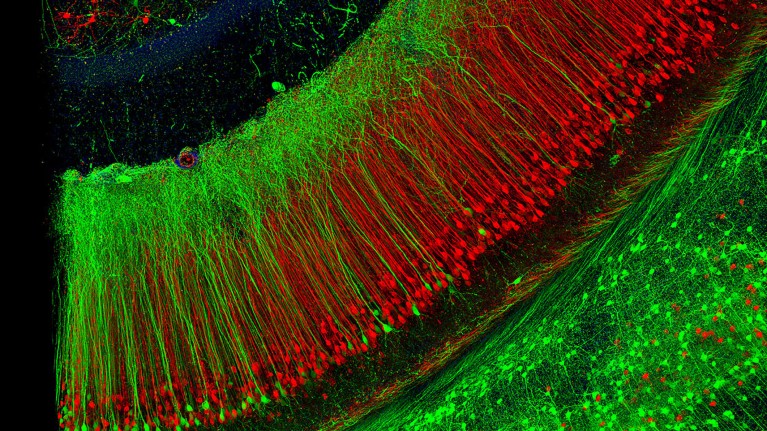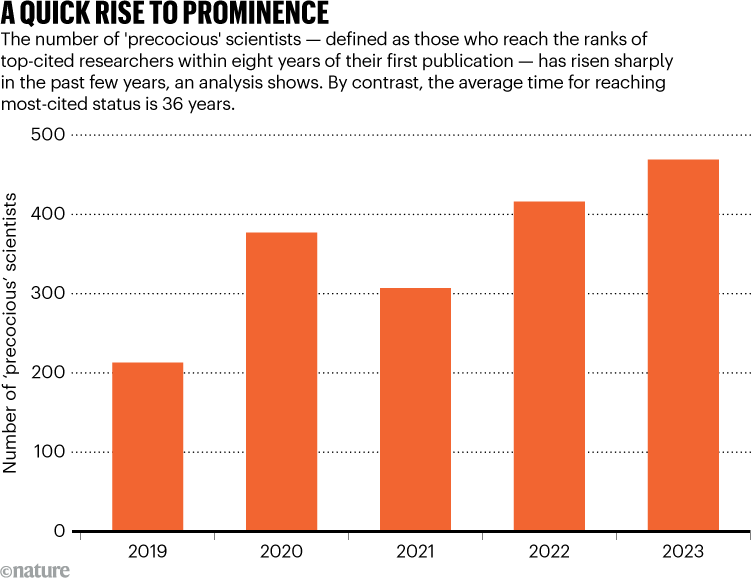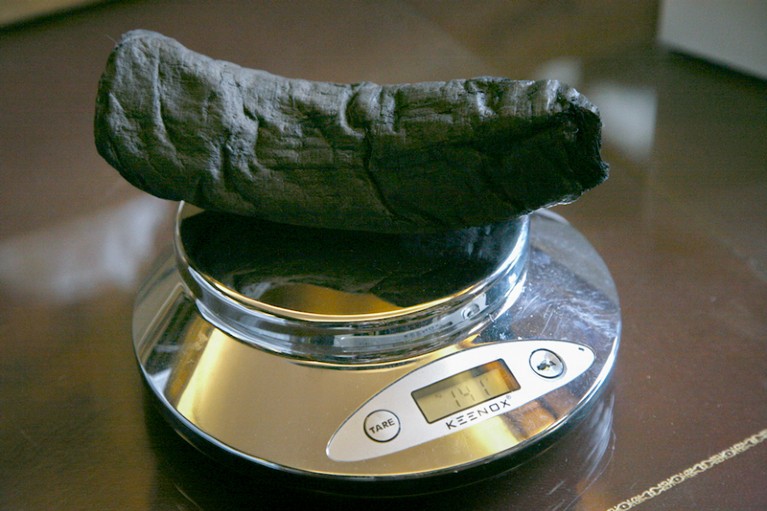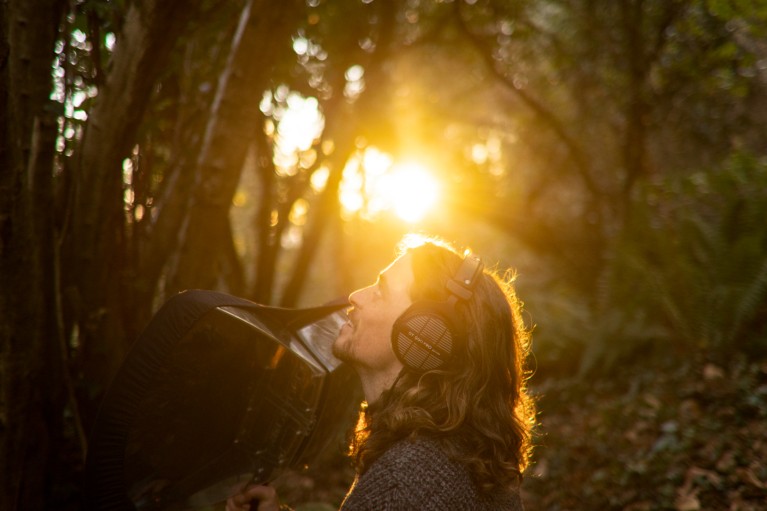Hello Nature readers, would you like to get this Briefing in your inbox free every day? Sign up here.

Artificially coloured nerve fibres in a mouse’s hippocampus, the brain region where new memories are encoded.Credit: Mark & Mary Stevens Neuroimaging & Informatics Institute/Science Photo Library
Mouse brains process old and new memories in separate phases of sleep, which might explain why new memories don’t overwrite existing ones. Researchers were able to glimpse mouse dreamland by watching the animals’ pupils get bigger and smaller while they slept. (Mice sleep with their eyes partially open during some stages of slumber.) The rodents forgot the location of a treat they’d been shown before sleeping if certain neuronal activity was disrupted during the small-pupil phase, but not during the large-pupil stage. “I put all my money that this segregation will also occur in humans,” says systems neuroscientist György Buzsáki.
Nature | 4 min read
Reference: Nature paper
Social isolation or loneliness could affect the levels of certain proteins in the body, which might explain why a lack of contact with other people is linked to poor health. In an analysis of data from more than 42,000 people in the United Kingdom, researchers found 175 proteins associated with social isolation and 26 associated with loneliness. Around half of them were linked to conditions such as cardiovascular disease and type 2 diabetes. Further analysis revealed that loneliness directly influences the levels of five proteins, all of which are related to inflammation and metabolism.
The Guardian | 6 min read
Reference: Nature Human Behaviour paper
Analysis of records in the Scopus citation database suggest that the number of ‘precocious’ scientists — those who become top-cited authors early in their careers — is on the rise. Some probably made it on to the list through talent and hard work, says physician-scientist John Ioannidis, who authored the preprint analysis. But there are worrying signs of questionable publishing practices: many precocious authors publish more than one paper per week and cite their own papers at an above average rate. “I don’t think that we’re all of a sudden mass-producing more geniuses now than we were five years ago,” says entomologist Zach Adelman.
Nature | 6 min read
Reference: bioRxiv preprint (not peer reviewed)

Source: Ref. 1
Features & opinion

Scrolls scorched in the eruption of Mount Vesuvius can’t be opened without damaging them.Credit: EduceLab, University of Kentucky
Last February, student researchers used machine learning to decipher the text hidden inside a charred, unopenable scroll from the ancient Roman city of Herculaneum. “In that moment, you really think ‘now I’m living something that will be a historical moment for my field’,” recalls papyrologist Federica Nicolardi. Now artificial neural networks are being used to translate the vast historical archives of Korean kings and decipher ancient languages of which only scraps of text survive.
Nature | 15 min read
Have some ancient Greek epigraphic text of your own to hash out? Ithaca, a tool trained on ancient Greek inscriptions, is freely available online.
The roll-call of creatures recognized by law as sentient — capable of feelings such as joy and fear — has expanded beyond the easily anthropomorphizable to animals such as octopuses and lobsters. So why not insects? Scientists have started to explore whether insects go beyond simple ‘reflex machines’ with experiments that aim to reveal something about their inner lives.
The New Yorker | 15 min read
This summer, leaders of global financial institutions will meet in Spain for a summit on funding the United Nations Sustainable Development Goals (SDGs). Finance is short in part because lenders like the World Bank insist that poor and indebted countries have to prioritize paying off loans to rich countries over investing in public services. Decision-makers should seize the opportunity to reform the rules of global finance that hobble health and wellbeing, argues a Nature editorial. “At a time when countries need to obtain significant extra financing to achieve the SDGs, many are instead battling to remain solvent.”
Nature | 6 min read
Where I work

Seán Ronayne is a freelance ornithologist in Cork, Ireland.Credit: Chris Maddaloni
Ornithologist Seán Ronayne is on a mission to record the songs of every regularly occurring bird species in Ireland. “Ireland’s nature is in a bad way, thanks to factors such as clearing land for agriculture, planting non-native conifers and removing hedgerows,” he says. “My work involves a combination of wooing people with the beauty of natural soundscapes, and saddening and angering them with the fact that these things are disappearing.” (Nature | 3 min read) (Chris Maddaloni)
Today I’m pondering the predictions of early-career scientists — for this year and 25 years from now — in haiku form. If you’re tempted to write your own, Science invites contributions on social media using the hashtag #NextGenSci.
Thank you for welcoming me back to your inbox in 2025! As always, your feedback on this newsletter — whether positive or critical — is very welcome at [email protected]. In return, here’s a very hastily written haiku:
Comments land like seeds,
Briefing grows with your insights—
A stronger bloom forms.
Thanks for reading,
Flora Graham, senior editor, Nature Briefing
With contributions by Jacob Smith
Want more? Sign up to our other free Nature Briefing newsletters:
• Nature Briefing: Careers — insights, advice and award-winning journalism to help you optimize your working life
• Nature Briefing: Microbiology — the most abundant living entities on our planet — microorganisms — and the role they play in health, the environment and food systems
• Nature Briefing: Anthropocene — climate change, biodiversity, sustainability and geoengineering
• Nature Briefing: AI & Robotics — 100% written by humans, of course
• Nature Briefing: Cancer — a weekly newsletter written with cancer researchers in mind
• Nature Briefing: Translational Research — covers biotechnology, drug discovery and pharma






